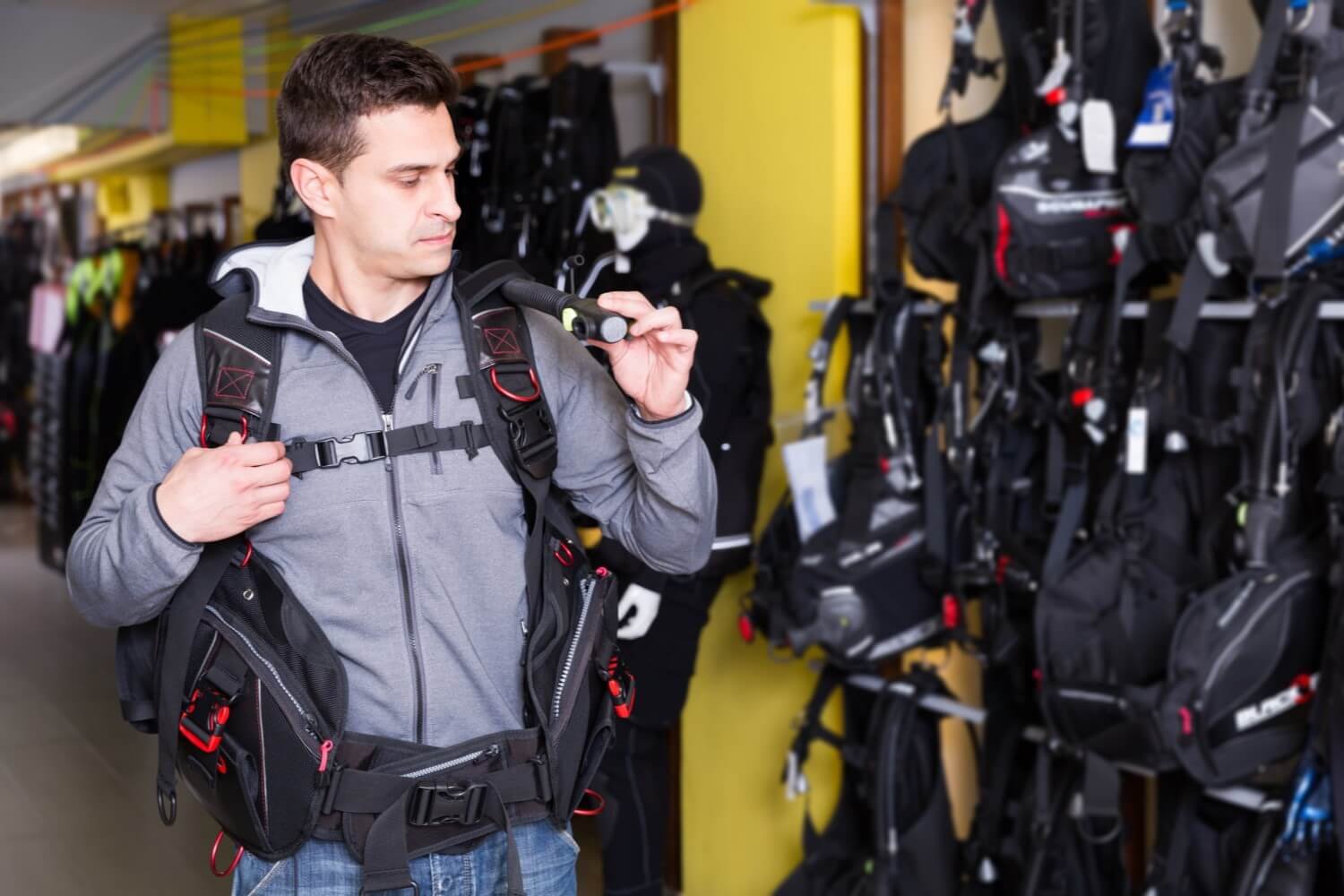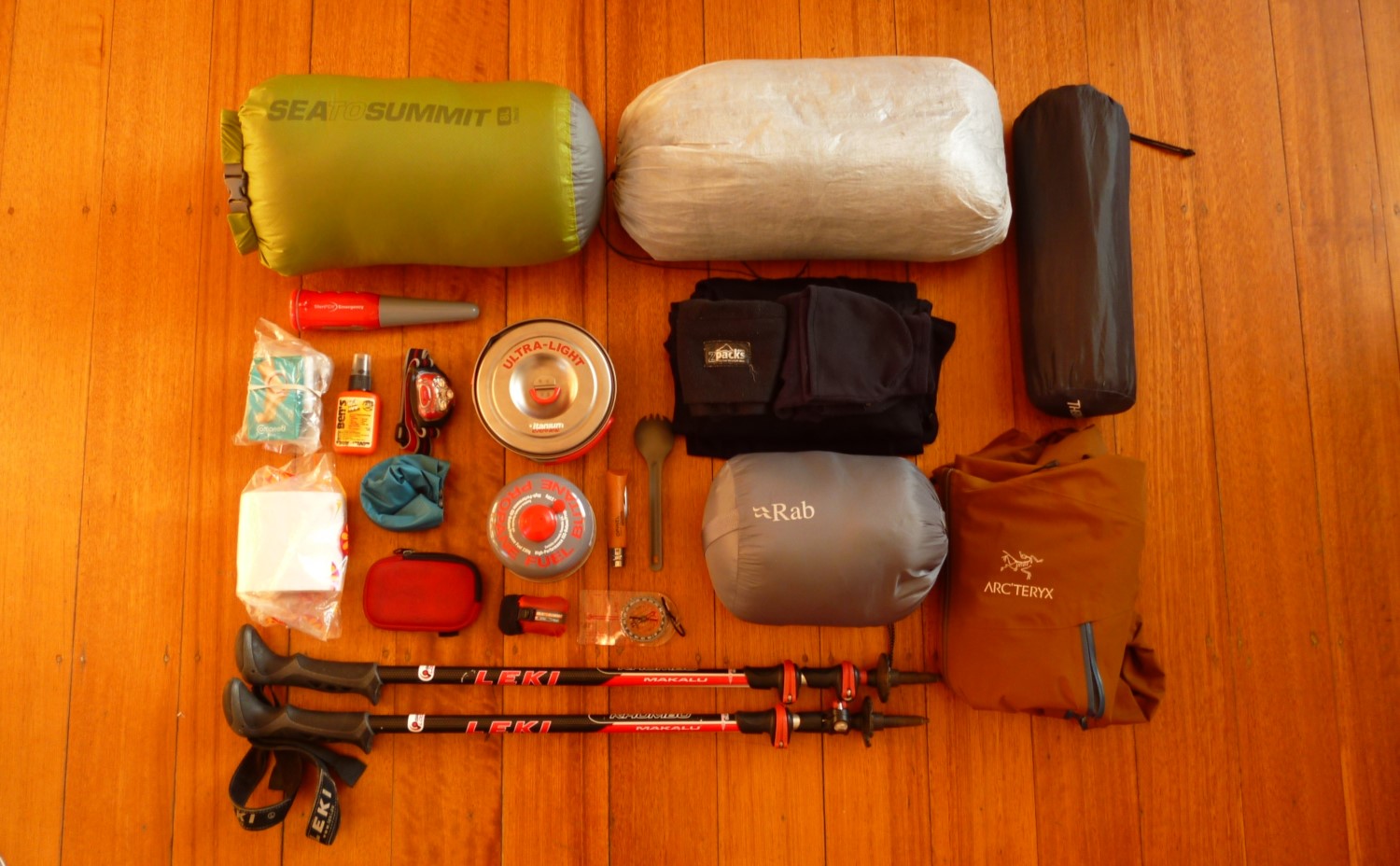Ultimate Guide to Buying Scuba Gear
JUMP TO: CHOOSING EQUIPMENT / PURCHASING EQUIPMENT / CARING FOR EQUIPMENT / SCUBA GEAR GLOSSARY
Author: Rose Martin
No doubt when you first learnt to dive you heard your instructor say a few things along the lines of ‘when you have your own gear’, ‘it really is worth buying your own’, or ‘we have some awesome equipment on sale’.
And if you’re anything like us, you probably dismissed these comments as the words of a hungry salesperson.
But as your love of diving grew, you probably got sick and tired of using battered rental gear that didn’t fit properly and realized that your instructor had a point – there are heaps of benefits of owning your own scuba gear.
Firstly, you can make sure you get the perfect fit. This means you’ll be super comfortable in the water, and your control and buoyancy will improve too (ever tried hovering in a BCD that’s way too big? …It’s not very graceful!).
Plus, you’ll know how much wear and tear your gear has been through, so you can replace it or have it serviced when the time is right (so it won’t let you down mid-dive).
Finally, although style might not be the most important reason to invest in your own gear, most divers love having coordinated gear and unique outfits that can be recognized underwater. For some, that’s sleek all-black outfits, while for others that’s hot pink numbers with blue accessories – whatever floats your boat!
So, decided to invest in your very own scuba kit? Awesome! But before you jump straight in there, check out our ultimate guide to buying scuba gear.
After all, scuba gear can be pretty pricey, so you want to make sure that you’re getting the gear that’s right for you!
CHOOSING YOUR EQUIPMENT
Beginner’s scuba gear list
As tempting as it can be to jump straight in and buy a load of gear at once, you’ll probably slow down and stagger your shopping when you see how much scuba gear costs. Plus, what gear you go for will depend on things like where you’ll be diving and your preferences when it comes to comfort and style.
As a beginner, it makes sense to start with the essentials (things you’ll need no matter where you are) and simple bits of gear that don’t need much technical consideration. So, if you’re about to start assembling your first dive kit, we recommend starting with the following:
COMPUTER/WATCH: Dive computers and watches tell you how deep you are, what your NDL is, and can be used to plan surface intervals and repetitive dives – pretty essential information no matter where you’ll be diving or how experienced you are!
MASK: A good-fitting mask makes all the difference to your dive. Over time, masks mold to the shape of your face to prevent leaks (unlike rentals that are used on so many faces they end up an odd shape!), so we definitely recommend picking one up ASAP. For more info see our round up of the Best Scuba Masks.
SNORKEL: Some people hate diving with a snorkel, but they can be lifesaving if you end up on the surface when it’s rough. They don’t cost much either, so there’s really no excuse for not having one in your kit (there are even super flexible ones you can pop in your BCD pocket for emergencies).
DSMB: It might not be the most exciting bit of kit, but a decent DSMB is an essential bit of safety gear that can save your skin if you get whisked away in a strong current. Good dive schools will provide them as part of your rental gear, but others (the ones with slightly dodgy health and safety standards!) might not, so it’s best to play it safe and pick up one of your own.
FINS: You can wear open-heeled fins in any temperature water, but closed-heeled fins are typically only worn in the tropics. So, if you aren’t sure where you’ll be diving just yet, why not play it safe and go for some open-heeded fins (check out our Best Scuba Fins article for more info on the differences between them).
Advanced scuba gear list
Okay, so the basic bits of gear mentioned above will serve you well for a while, but eventually you’ll want to move on and get the whole set. So, when you’re ready to invest a little more in your dive kit, and know where you’ll be diving most often, you’ll no doubt start thinking about the following:
BCD: Having your own BCD is great for comfort and control, and there are loads of different designs out there. However, if you have back troubles, we definitely recommend purchasing a BCD with an integrated weight system, so you don’t have to carry all your weight on your hips (which often makes backs unhappy!).
REGULATOR: The main reason people invest in their own regulator is to avoid spreading germs (even pre-corona!), but it also means you don’t have to worry about borrowing regulators with chewed mouthpieces and you can leave the airflow settings just how you like them. See our Best Scuba Regulators guide for more info.
WETSUIT/DRYSUIT: We’ve added these to the ‘advanced gear’ list because it can take a while to figure out how much you feel the cold! Before you invest in a suit, try out a bunch of short and long wetsuits, or even dry suits, to see which suits you.
Scuba gear accessories list
As well as essential scuba gear, there are also heaps of scuba accessories on the market. Which ones are right for you will depend on things like what temperature water you dive in, and even how long your hair is, and will be different for every diver. But in case you need some inspiration, here are some of our favorite scuba accessories:
BUFF/HEADBAND: Perfect for keeping long hair out of the way!
SLATES: Great for communicating if you’re carrying out complex tasks underwater.
MASK STRAPS: To (try) and keep your hair unattached to your mask.
TABK BANGERS/OTHER AUDIBLE DEVICES: So can you always let your buddy know when something cool swims by (or get their attention in an emergency)!
TORCH: These are a must-have for any avid wreck divers.
KNIFE: These are super important if you’ll be diving around kelp forests or other sites where entanglement is possible.
GLOVES: If your hands are cold, you won’t be able to perform important emergency procedures underwater (like reattaching your LPI hose), so make sure you pick up a pair of gloves if you need them.
CLIPS: No matter what accessories you go for, it’s a good idea to have some clips handy so you can make sure you keep hold of them on your dive.
PURCHASING YOUR EQUIPMENT
How expensive is scuba gear?
As you’ve probably realized by now, scuba diving isn’t the cheapest of hobbies, and buying you own gear will certainly put a dent in your wallet. But it’s not all bad news… having your own gear will most likely save you money in the long-run because most dive centers offer discounts to people who arrive fully (or even partially) equipped for a dive.
Plus, if you’re lucky enough to live near the sea, owning your own gear means that you can cut out dive centers (and their fees) all together and head off for a shore dive whenever you feel like it (as long you have somewhere to fill your tanks!).
If you shop around carefully, you can get yourself a decent set of basic scuba gear (snorkel, mask, fins, and computer) for as little as USD $250. But, as soon as you throw in a BCD, wetsuit, and regulator into the mix (or just upgrade your computer!), this can soar to $850.
On the flipside, if you’re into high-end techy gear, expect to splash out as much as USD $900 on basic dive gear alone… and $5000+ on a full set.
So, scuba gear may be expensive but, if you shop wisely, it’s totally worth it. Here are some tips on purchasing your own gear, so you can make sure that you’re getting your money’s worth:
Get your geek on
We definitely recommend doing some thorough research when it comes to buying scuba gear. While it’s easy to go for the ‘prettiest’ or best-known model, some brands offer better value for money than others, so it’s worth checking out all of the nitty gritty specifications before you buy anything. You can find the specs for most bits of gear online, and you can always pester other divers about their gear as an extra bit of ‘research’!
Try before you buy!
With online shopping the norm these days, trying things before you buy them is becoming somewhat of a luxury. Luckily, however, you can return most online purchases if they don’t fit properly. But the trouble with scuba gear is that it might feel fine on land and totally different underwater.
So, the best thing to do is try out different bits of kit on actual dives before investing in your own gear – this might be by using different bits of rental gear, borrowing gear from a friend, or by attending your local dive club night.
Where should I buy new scuba gear?
So, once you’ve done your research, and (hopefully) been diving with the gear you want (or at least something similar), you should be ready to pick up one of your very own.
ONLINE STORES: There are thousands of websites where you can buy gear online, and you’ll find some great deals too. You need to make sure that the site you’re buying from is legit though – and make sure you check out the returns policy too (you don’t want to end up stuck with anything you don’t like). One of our favorites for product range and returns policy is Leisure Pro.
LOCAL STORES: Alternatively, why not pop down to your local store and check out what they have to offer. This can be a great option if you haven’t managed to borrow the gear you’re after beforehand because you can get expert advice from the people who work there. Plus, many stores offer loyalty schemes, so you might end up with some great deals if you return to the same store.
DIVE CENTERS & CLUBS: You can also pick up bits of gear while you’re on holiday. In fact, many dive centers sell the exact same gear that they rent – so you really can try before you buy! Finally, lots of dive clubs not only let you try on bits of gear, but they sell it too. And your club membership might get you some awesome deals too.
And what about used scuba gear?
Purchasing used scuba gear is a risky game – you just don’t know what that gear has been through before it met you.
ONLINE: If you’re buying second-hand gear online, and there’s no returns policy, we recommend only going for basic bits of equipment (mask, fins, snorkel, wetsuit, etc.) – you should be able to tell what kind of condition they’re in just from looking at them. Plus, your dive shouldn’t go too horribly wrong if they turn out to be faulty.
If you do purchase more technical gear (like a regulator or BCD), then we definitely recommend getting it serviced before you head out diving with it – or, at the very least, testing it out in a pool first to make sure that it’s in working order.
PEOPLE YOU KNOW: If you’re buying gear from a friend or family member, you can probably relax a bit – they’re likely to tell you exactly why they’re getting rid of it and what condition it’s in. But, even then, there’s no harm in trying it out in a pool before you head out into open water.
DIVE CENTRES & CLUBS: Some dive centers and clubs let you purchase rental gear after you’ve used it. This is great for some items, like fins, because you can be sure that they’re the right fit (and it’s cheaper than buying them brand new). But, again, when it comes to complex gear, we’d steer clear of buying second-hand (but if you do – make sure you get it serviced!).
Key considerations when buying equipment
So, once you’ve decided what gear to buy and where to buy it, what are the key things you need to think about?
FIT: Your gear needs to fit you properly, of course! Which is why it’s great to ‘try before you buy’ whenever possible.
Generally, never turn down a chance to try out a new bit of gear – the more sizes, brands, and models you try, the more you’ll get a feel for what suits you best. For instance, after trying on several friends’ wetsuits, I know that I will never fit in a Cressi wetsuit (I’m just not the right shape for them), but I know a Mares wetsuit in my size will fit even without trying it on.
There are also specific tricks you can use when trying on equipment, to see if you have the right fit (like the ‘inhale test’ for scuba masks) – which is why trying gear on in store can be so great (the salesperson should know all the tips!).
COMFORT: All scuba gear should be comfortable, otherwise you won’t end up wearing it, and what’s the point in that? You might be tempted to squeeze into those fins because they’re the last ones in store, they’re on discount, and they’re your perfect style but, if you aren’t totally sure about the way they rub on your ankle, don’t do it!
WHERE WILL YOU BE DIVING? This is a huge factor to think about when buying scuba gear. If you’re heading to tropical climates on your next dive trip, your kit might include closed-heeled fins and a 3mm shorty. But if you’re heading to Europe, you’ll probably want open-heeled fins with booties, a dry suit, and heaps of other accessories (hood, gloves, etc.).
Plus, if you’re brave enough to dive in icy waters, you’ll need to make sure your equipment can operate safely in the cold (for instance, you’ll need a special type of regulator).
VALUE FOR MONEY: It really is up to you how much you spend on scuba gear. If you have cash to splash, then the sky’s the limit, but the good news is that there are loads of great value budget options out there too.
The main thing is to make sure that, no matter how much you’re paying, you’re getting your money’s worth – there’s no point spending a fortune on mediocre dive gear!
If you do you research beforehand, you can find out the pros and cons of each bit of gear, so you know what you’re letting yourself in for (for instance, if you go for a cheap BCD you might expect it to last for 5 years, but perhaps online reviews will tell you that the next model up, which is just $200 more, might last you for 10!).
When purchasing equipment, you’ll want to consider where you’ll be diving. For example, If you’ll be diving wrecks, then a torch is going to be an essential accessory.
CARING FOR YOUR EQUIPMENT
Although most scuba gear comes with fairly hefty price tags, the good news is that, if you show it some TLC, it should last you for hundreds (or thousands!) of dives.
Rinsing
As anyone who spends a lot of time on, in, or near the ocean knows, salt water is a real pain. As well as degrading soft materials, like neoprene, it hones in on metal and causes corrosion, so it can destroy even the toughest of gear. And even freshwater sites, like lakes, can contain minerals and other molecules that can harm your gear.
That’s why you should always rinse your gear with freshwater as soon as possible after diving. Most dive centers have some kind of ‘rinse bin’ where you can dunk your gear. Rinsing alone is enough for basic gear (mask, fins, wetsuit, etc.), but remember that some bit of gear require further attention.
RINSING YOUR BCD: BCDs are one of the most expensive bits of diving equipment, and so we reckon they deserve more than just a quick rinse.
Fully empty the saltwater out of the BCD, then fill it again with freshwater using the LPI hose. Add a few breaths orally and spin the jacket around a few times, thoroughly rinsing the inside. Then, release freshwater out of each of the dump valves, as well as out the top of the hose, to stop the valves from clogging.
Repeat these steps a few times, then orally inflate your BCD, extend the shoulder straps (so they don’t dry with a kink in them), and leave to dry (out of direct sunlight).
RINSING YOUR REGULATOR: Before you head anywhere near a rinse bin with your reg, make sure that the dust cap is dry (lots of people do this with a burst of air from a tank) and firmly in place.
Keep the first stage out of the rinse bin, but let the other parts of the regulator soak for a few minutes (the second stages, SPG, etc.) – you can even add some mouthwash or alcohol to the water for a proper clean.
People tend to have different methods for rinsing the first stage, but the main thing is to make sure no water gets inside. Methods include gently splashing some water onto the first stage, submerging it very briefly (with the dust cap attached), or rinsing it while it’s still attached to the tank – it’s up to you really!
Avoid direct sunlight
Sometimes it’s hard to avoid your gear getting some sun immediately after a dive – but try to leave it in the shade or under a cover while you’re in transit (otherwise you risk your gear getting damaged by harmful UV rays). Plus, once you’ve rinsed your gear, leave it to dry in the shade not the sun (it’ll take longer, but your gear will thank you for it!).
Maintenance and servicing
People often hesitate to buy their own gear because they fear taking responsibility for its maintenance. But cleaning and maintaining scuba gear really isn’t as bad as you think – as long as you do it frequently and not beyond the scope of your training (there are experts on hand for anything you can’t do!).
Some bits of gear only need a deep clean every now and then. For instance, sand and other debris can accumulate in the gap between the silicone and glass of your mask. Usually (but check the instructions for your model), disassembly is simple – just pop the glass out of the frame and pries out the grime with a toothbrush or toothpick. There are even handy tools (like this one) that help with the disassembly.
You can also treat your regs to the odd deep clean. This could be a long soak for the second stage in antibacterial mouthwash, or removing the cover if you drop it in the sand and there are some grains hiding in there (the last thing you want is a mouthful of sand on your next dive!).
But some bit of gear need additional servicing by experts to make sure that they continue to operate safely. For instance, most regulators come with specific servicing guidelines, and some will recommend a check-up every 12 months or 100 hours underwater, whereas others might recommend every 36 months or 300 hours. It’s important that you stick to these guidelines – not only for your safety but also to maintain any warranty that came with the product.
Plus, no matter what the guidelines say, you should always take your gear in for an early service if you notice it behaving oddly or suspect it might be damaged.
Insurance
But even if you do everything right in terms of maintenance, accidents and unexplainable malfunctions do sometimes happen. And that’s why some people opt for dive equipment insurance, which typically covers loss and theft too. Policies certainly aren’t cheap, but if your gear is super expensive or you travel a lot, it could be well worth it.
If your gear isn’t super expensive, and you don’t travel so much, you might be better off keeping hold of your warranties and purchasing add-on insurance for any particularly expensive products you buy (rather than a whole dive insurance package).
SCUBA GEAR GLOSSARY
When you’re new to scuba diving, there’s a lot to take in. You have to remember what each bit of equipment is called, where it goes, and what it does… not to mention all the slang words and acronyms you’ll hear thrown around the boat too.
Here are some of the most common terms (official and slang) that you’ll hear when it comes to scuba gear. But if you are looking for our ultimate glossary for all scuba diving terminology, then you can check it out here.
ALTERNATE SECOND STAGE/OCTOPUS: This is your back-up second stage (a spare mouthpiece and purge valve at the end of a separate hose). These are only used during training or in emergencies.
BC/BCD/JACKET: BCD stands for ‘buoyancy control device’ and refers to the jacket-like bit of equipment you wear when diving. Because you can add and release air, this jacket is used to control your buoyancy underwater and at the surface, hence the name.
BOTTLE/CYLINDER: These both refer to your scuba tank.
DSMB: DSMB stands for delayed surface marker buoy, and they’re typically attached to a reel. Divers can add air to these buoys (so they rise to the surface) while remaining at depth and holding the reel, so they’re a great way of letting people on the surface know where you are.
DUMP VALVE: You might hear this one in your buddy checks. Your dump valves are located on your BCD. There’s usually one on the shoulder and sometimes a second one behind your kidney. They let you release air quickly (AKA ‘dump’) in the case of an emergency, like a rapid ascent. To check them during your buddy check, fill your BCD with air and pull the toggle(s) – you should feel some air release.
FLIPPERS: You might get laughed at for this one… but some people still call fins ‘flippers’.
LONGY: A ‘longy’ (or fullsuit) is a wetsuit that covers your legs and arms completely.
LPI: LPI stands for ‘low pressure inflator’. These are used to add and release air form your BCD and are found at the end of a hose coming from the first stage.
RASHY: A ‘rashy’ is a rash vest designed to stop skin irritation. Some people wear them underneath their wetsuits for comfort, but some people wear just a rash vest when diving in warm water (many come with sun protection too).
SHORTY: A ‘shorty’ is a wetsuit that is cropped at the legs (covering just the thighs) with either cropped or full-length arms.
SMB: SMB stands for surface marker buoy. If you’re on a guided tour in an area with current, your guide will most likely have one of these buoys attached to reel with them throughout the entire dive (so the boat captain knows where abouts you are).
PRIMARY SECOND STAGE: The primary second stage (or just ‘primary’) is the part of the regulator you breathe from (the mouthpiece and the purge valve). It’s called a primary to distinguish it from your alternate second stage (or octopus).
SPG: SPG stands for submersible pressure gauge, and it tells you how much air you have left in your tank. They typically also display the depth, although most people now use computers for monitoring depth instead due to their greater accuracy (but SPGs make great backups).
Want to learn more scuba terminology? Be sure to check out our ultimate scuba diving glossary.
MORE INFORMATION
Looking for more information on diving? Be sure to check out some of our other diving content:
Or check out our entire Gear Reviews Page for more diving and outdoors related content.
Enjoy the underwater journey!





















